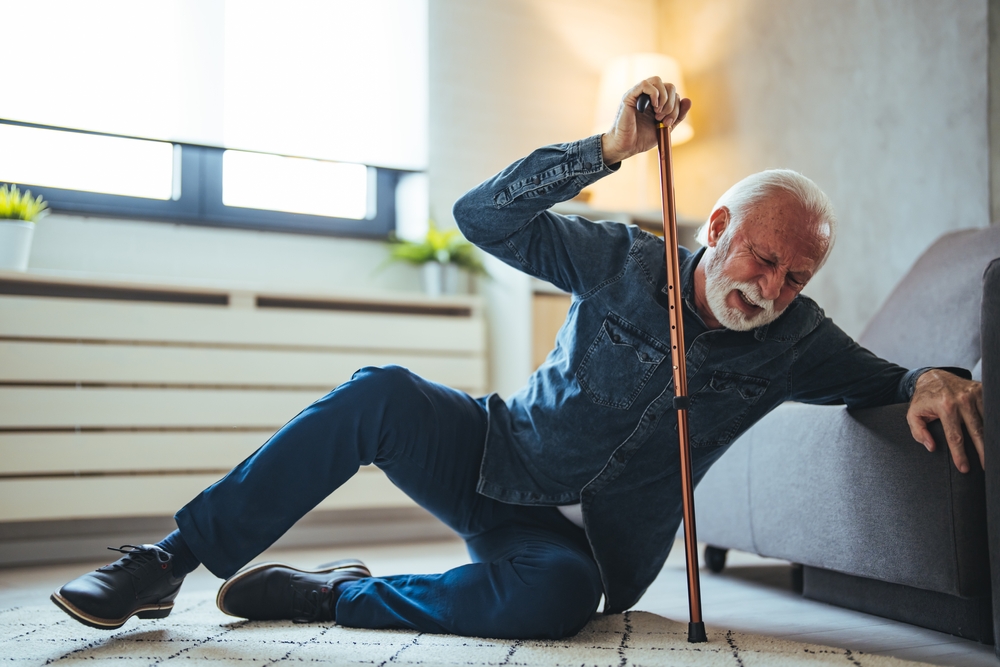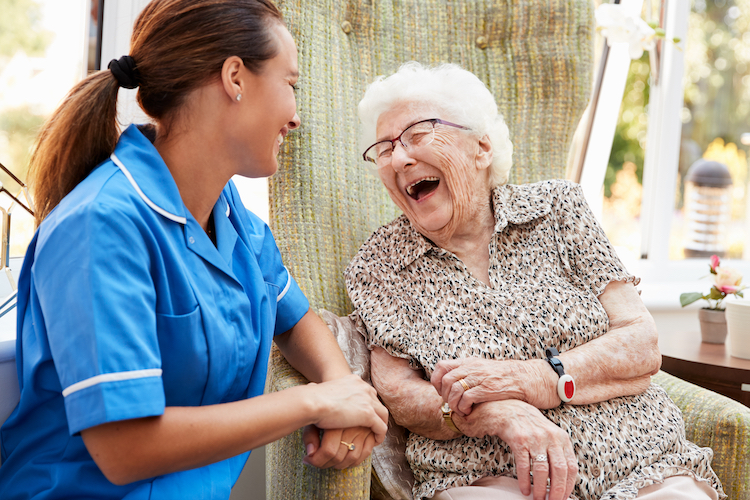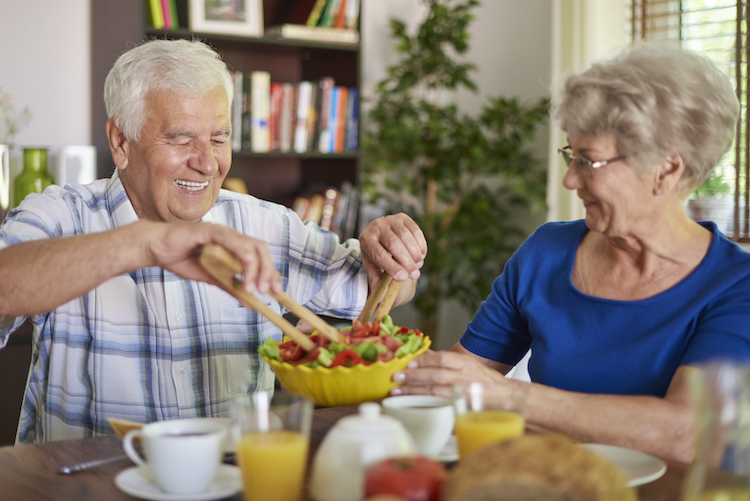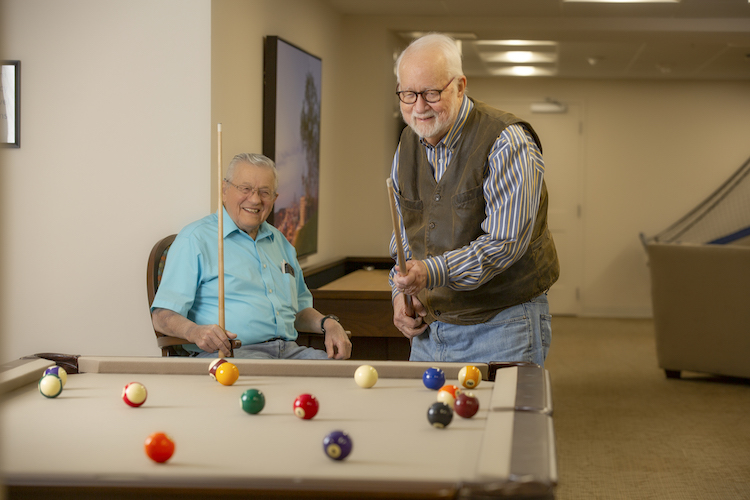One of the most significant hazards for seniors is the risk of falling. Because our bones become more brittle and fragile as we age, something as simple as tripping and falling can easily lead to an emergency room visit! Did you know? Fall injuries, like hip fractures and head injuries, send nearly a million seniors to the hospital each year.
Because falling is so much more likely to cause severe injuries in adults over the age of 65, it’s crucial to assess lifestyle, health, and environment to avoid potential hazards. Let’s discuss fall prevention for seniors and what can be done to keep yourself or your loved one safe!
Health Risk Factors for Falling
Older adults are more likely to lose their balance because of other physical conditions that limit their mobility and reliability on their feet. Some health-related risk factors that increase the chances of a fall include:
- Vertigo
- Weak muscles
- Vision or hearing problems
- Diabetes
- Osteoporosis
- Mobility issues that require the use of a walker, wheelchair, or cane
- Decreased cognitive function (i.e. dehydration due to memory loss)
- A previous history of falling
- Medications that cause weakness, light-headedness, dizziness, or drowsiness
If you or your loved one have one or more of these risk factors involved, you should assess the living environment to remove trip hazards and possibly install supportive devices to decrease the risk of falling!
Environmental Fall Prevention for Seniors
Even if you or your loved one are at a higher risk of falling, some simple changes to their home or apartment can decrease the chances of injury. Here are some adjustments you can make to different areas of the home that will increase fall prevention for seniors, regardless of their senior living situation:
Bathroom
The bathroom is a dangerous place to fall, especially in tight spaces where falling will likely result in an injury on the counter, toilet, or bathtub. Here are some ways to reduce the chances of a fall in the bathroom:
- Remove throw rugs (even if they have anti-slip mats underneath).
- Install mobility support bars along the walls, especially near the toilet and in the shower or tub.
- Place reliable anti-skid pads on the shower or tub floor.
- Make getting on and off the toilet easier with a raised toilet seat (many of which come with handlebars for added support).
- Use a shower seat.
- For seniors aging at home, consider remodeling the bathroom to replace a tub/shower combo with a ledge-free walk-in shower.
Kitchen
Falling in the kitchen can be particularly unsafe because of the many sharp objects and hot appliances. Here is how you can make it safer:
- Keep dining table and chairs to the far side of the room rather than in the middle of high-traffic areas.
- Put non-skid backings under mats near the sink and stove. Mats are still helpful in these areas as they can otherwise become slick from water or grease.
- Keep heavy countertop appliances on the counter and ready to use rather than stowed away in cabinets.
- Store dishes, utensils, cooking and baking tools, cups, and food in easily accessible places to eliminate the need for a step stool. If this means some high shelves remain empty, use that space for long-term storage items that aren’t frequently used.
- If a stepstool is necessary, get a sturdy one with handrails for support.
- Make sure the flooring is level.
- Add motion-sensing lights to the pantry and cabinets to improve visibility.
Living Room, Bedroom, Etc.
While the bathroom and kitchen are full of hazards that need to be addressed, the rest of your home still deserves attention to reduce the likelihood of a fall! Most of these changes come down to simple decluttering and rethinking how the furniture is arranged. Here are ways to avoid tripping in the living spaces of your home:
- Repair or replace wobbly, unreliable, or rocking furniture.
- Move small furniture items against walls and out of walkways.
- Get rid of any throw rugs that could easily shift and become a slip or trip hazard.
- Reduce clutter to create a more open, obstacle-free space.
- Ensure good lighting to help with vision.
- Keep electrical cords wrapped up against the walls and out of the way. If you have electronics that require cords stretching across walkways, rearrange the furniture to place these against walls or replace them with wireless alternatives.
Stairs and Steps
Homes with stairs or steps should take extra care with fall prevention measures, as falling down steps of any height can result in serious injury. Here are some ways to make stairs and steps safer:
- Install handrails on both sides of the stairs.
- Consider a stair elevator chair for particularly difficult and tall stairways.
- Add fluorescent tape strips on the edge of non-carpeted steps.
- Install carpet or non-skid treads on hardwood or other possibly slippery steps.
- Improve lighting around stairways.
Other Fall Prevention Tips
Now that the home is fall-proofed, it’s time to fall-proof the lifestyle! Here are some things you can do personally to decrease the risk of falling:
- Wear skid-proof house slippers or non-skid socks around your home, and shoes with non-skid soles while out.
- Avoid leaving objects lying around in walkways.
- Don’t use stepstools or ladders or climb on top of chairs to reach high-up items. Ask for help!
- Get your vision checked — it might be time for new glasses!
- Consider getting a cane or walker if you don’t yet have one.
- Train your pet not to get caught up underfoot or lie down in walkways.
The Best Fall Prevention for Seniors is Senior Living!
While some seniors may start out aging at home, increasing falls may be a sign that it’s time to consider a lifestyle change. Senior living communities like St. Anthony’s provide excellent fall prevention for seniors with spacious apartments, oversized bathrooms with walk-in showers, on-site medical support, and additional mobility care for those who need it.
Contact us to learn more about how St. Anthony’s makes senior living safe, comfortable, and enjoyable for older adults!




